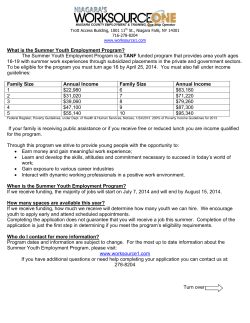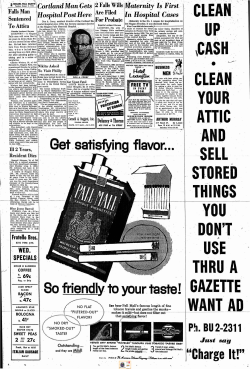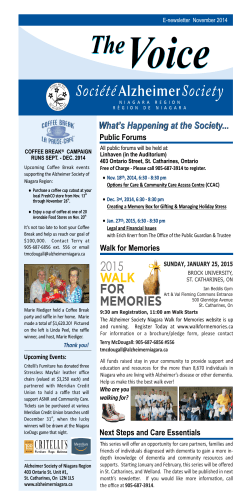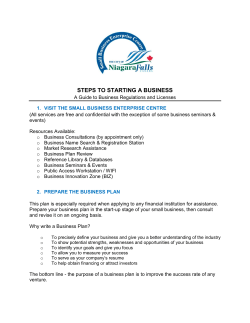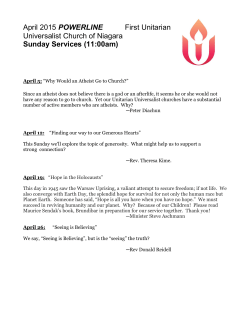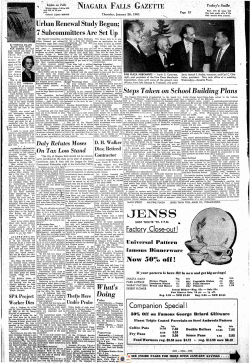
CRT Comments on NGC Project
30 March 2015 Mr. Thomas Donohue Niagara Gorge Corridor Project c/o Parsons Transportation Group 40 LaRiviere Drive – Suite 350 Buffalo, NY 14202 Dear Mr. Donohue: Representatives from Citizens for Regional Transit attended the Niagara River Gorge Project public meeting on February 19th. and are writing this letter offering our comments and recommendations. We want to thank the Niagara Gorge Corridor (NGC) Project Team for initiating and leading this important work. We hope that feedback received will help establish a plan that takes best advantage of the unique location and character of the Niagara River Gorge and reflects the concerns and desires of citizens. Citizens for Regional Transit (CRT) is working with the Western New York Environmental Alliance (WNYEA) to recommend that transportation along the Niagara River Greenway as a whole use non- or minimally-polluting public transit. The recommendations in this letter reflect our work with the WNYEA. For example, we are recommending that electric buses or modern streetcars be included in the Niagara Gorge Corridor plan to efficiently move people along the NGC. This would reduce pollution, limit traffic load from private vehicles, enhance the public’s experience along the scenic gorge, and serve as a component of a larger regional Niagara River Greenway transportation network. While we are pleased that several project objectives of the NGC Project address efficient transportation, we are disappointed that the proposed design puts little emphasis on public transit. The presentation did not mention public transit (at least not during the earlier session) and the maps merely indicate the location of a “potential future trolley connection.” If there is to be an on-street trolley along the greenway, there is no indication of (1) how far north the trolley will go, (2) where stops will be – even notionally, and (3) whether bus shelters and bump-outs are envisioned for comfortable loading. By contrast, the plan identifies areas where there will be parking. It seems that the primary mode of transportation envisioned is cars. We believe this is a mistake. There are estimated to be 8 million visitors to Niagara Falls, NY each year. One Project Objective is to encourage visitor migration into local business districts and encourage longer stays. If large portions of the millions of visitors decide to explore the new improved Niagara River Gorge, and do so by car, we are likely to see traffic congestion, demand for more parking areas, increased pollution, and a degraded visitor experience. These impacts are all in direct contradiction to the stated Niagara Gorge Corridor Project objectives. Public transit along the gorge corridor should be a primary design element to avoid these negative effects, not a possible future consideration as stated in the material distributed at the meeting. Visitors to Niagara Falls should have ready access to a user-friendly transit map showing connectivity to all area tourist destinations, such as the one shown in Figure 1. Compare the relative numbers of visitors to the various attractions along the Niagara River Greenway today to the distribution of visitors to attractions at Disney World, where they are all connected by transit (see Figure 2). The numbers speak for themselves. Connecting our attractions with convenient transit would increase the number of visitors to them. Today travelers expect public transit to be available – especially international tourists and millennials. To omit transit from Niagara Gorge Corridor plans would constrain many of our visitors and forfeit significant economic benefits. Figure 1. Public transit along the Niagara River Greenway is essential for moving large numbers of visitors without traffic congestion and pollution. It needs to be a central consideration of the Greenway Plan. Figure 2. The goal of attracting visitors to extend their stay is enhanced with public transit as demonstrated at Disney World. Canada’s successful WeGo Transit System offers a model to follow (see Figure 3). Tourists to Niagara Falls, Ontario find easy access to public transit connecting attractions along the Canadian side of the border. Articulated buses, large comfortable shelters, high frequency service, and a website that emphasizes easy connectivity via public transit all work together to make their attractions successful. The U.S. side needs to do the same. The Niagara Gorge Corridor Project offers a rare chance to do this, or at least lay the groundwork. Let’s not miss the opportunity! Figure 3. Canada’s WeGo System offers a model to follow. The Niagara Gorge Corridor Project objectives (to improve access and transportation, promote and conserve the ecology and environment, support local economic vitality, minimize impact to neighborhoods, and support the Niagara River Greenway Plan) are all enhanced with public transportation and degraded by private vehicle congestion. The Gorge Project objectives with relevant sub-objectives are listed below with an indication of transit’s role in their achievement. Table 1. Public Transit Provides Is an Important Element in Achieving the Niagara Gorge Corridor (NGC) Project Objectives NGC Project Objectives 1. Improve access and transportation. C. Link parks, communities, and attractions adjoining the NGC. 2. Promote and conserve the ecology and environment of the NGC. A. Reduce environmental impact of transportation related activities. 3. Support local economic vitality. A. Encourage visitor migration into local business districts. B. Create an atmosphere that encourages visitors to remain in NGC region longer E. Provide effective wayfinding information 4. Minimize impacts to adjacent neighborhoods. A. Promote vehicle travel patterns that minimize traffic impacts in residential areas. 5. Support the Niagara River Greenway Plan. A. Increase access to and connections between the Niagara River region’s many resources. B. Celebrate and interpret our unique natural culture, recreational, scenic, and heritage resources in the NGC area and provide access to and connections between these important resources while giving rise to economic opportunities for the region. How Addressed by Transit Public transit provides direct linkage between parks, communities, and attractions along the NGC. And it is accessible to everyone, including tourists who are unfamiliar with the area and anyone without a car. Transit will also reduce congestion to improve access for those who do choose to drive. The best way to reduce the environmental impacts of transportation related activities is with green public transit. This produces far less pollution and reduces traffic congestion. Transit oriented development (TOD) is now recognized as an engine for stimulating economic development. A transit line lays out what there is to see and delivers visitors right to each attraction. This provides effective wayfinding and encourages longer stays. The best way to minimize traffic impacts is to minimize traffic. Public transit does this by providing an alternative to the car. This is especially important since Whirlpool Street abuts residential areas where drivers might look for parking spaces if too many people use cars to explore the gorge. Public transit increases access to and connections between the Niagara River’s many resources for everyone, both transit riders and motorists who experience less traffic congestion. It also reduces the amount of land needed for parking. For the reasons summarized in Table 1, the Niagara Gorge Corridor Plan should emphasize public transit and discourage travel by private vehicle. The current plan does not do this and needs to be modified. Irrespective of transportation mode of arrival in the NGC, once here public transit should deliver visitors efficiently to various attractions without requiring them to drive and park multiple times. Recommendations: The best approach for integrating green public transit into the plan is with dedicated rights-of-way. At the very minimum, public transit vehicles should be given priority in places where alignments must be shared with cars. Transit vehicles can be rubber-wheeled trolleys; however, long-term plans should include the option of modern streetcar. Niagara Falls is a world-class tourist destination. World-class public transportation is called for. The NGC Project Plan should include public transit as a primary design element. We agree that the Robert Moses Parkway (RMP) was a mistake that needs to be undone. It separated the City of Niagara Falls from the river and put a four-lane limited access highway right next to Niagara Falls, one of the world’s most beautiful natural wonders. The redesign needs to reconnect the city with the river and restore green space along the gorge. But it must also be able to accommodate the movement of potentially large numbers of people to the many attractions along the river, as described above. Dedicated transit lanes, perhaps in the middle section of a wider Whirlpool Street, could accomplish this. For example, the alignment in Figure 4 shows this approach, with only moderate reduction of the amount of natural area available along the gorge. On the south end of the project, the section of Whirlpool Street that connects with First Street under Option C could serve as dedicated transit lanes along this part of the NGC. The maps in the NCG Project handout should indicate the location of the new Niagara Falls Multimodal Transportation Center / International Railway Station. This will be a significant activity center and traffic generator (e.g., cars, buses, trolley, hotel shuttles, etc.). As a museum site and visitor arrival gateway, it should be highlighted, labeled, and included as a key transportation component on all maps. According to the handout, the orange multimodal trail between the Falls and the Discovery Center will carry pedestrians, bicyclists, and a trolley. With a minimum width of 13 feet, will this be wide enough for all this traffic and for trolleys to pass each other when going in opposite directions? We assume this narrow width will only occur along isolated sections of the path where a greater width cannot be accommodated. It will be important that trolleys be able to pass each other when traveling in opposite directions. Finally, we were disappointed that there was no opportunity for the public to voice concerns and ask questions at the conclusion of the presentations. Meaningful audience engagement is important for ensuring that the plan reflects citizens’ desires regarding the use of this public land – and for tapping the expertise of people and organizations knowledgeable about issues relating to the NGC. Restricting comments to written submissions and informal small group discussions does not provide a way for citizens to raise questions publicly, and does not allow the design team to respond openly so everyone can hear. We want a chance to publicly share our views and to be informed by the views of other groups and citizens. The Niagara Gorge Corridor Project Team should want this too. Microphones should be available for this purpose at future meetings. Figure 4. Comparison of proposed Whirlpool Street alignment with an alternative that incorporates dedicated bus lanes. Significant transit capacity is provided with only a 17% reduction in the natural area width. Thank you for your hard work in developing these plans and for considering our comments. We are willing to meet with the design team, and any of the area leaders copied on this letter, to discuss any of these items. Our contact information is given below. Sincerely, Douglas Funke President, Citizens for Regional Transit 716-691-8528 [email protected] Website: www.citizenstransit.org Facebook: “CitizensforRegionalTransit” Twitter: WNYTransit CC: Niagara River Greenway Commission: Chairman Greg Stevens, all Greenway Commissioners Niagara Falls: Mayor Paul Dyster, Senior Planner Tom DeSantis, City Council Members Niagara County Legislators Village of Lewiston: Mayor Collesano, Village Board Town of Lewiston: Supervisor Brochey, Town Board Village of Youngstown: Village Board Town of Porter: Supervisor Merton Wiepert, Town Board Niagara County: Executive, legislature NY Legislature: Assemblyman Cereto, Senator Ortt Congress: Congressman Brian Higgins, Senator Charles Schumer, Senator Kirsten Gillibrand Buffalo Niagara Partnership: Dan Leonard Fort Niagara: Director Robert Emerson Art Park: Director Visit Buffalo-Niagara: President Patrick Kaler Niagara USA Niagara Heritage Partnership GBNRTC: Executive Director Hal Morse
© Copyright 2026

